Introduction
Nonwoven textile is made of long fibers, assembled together by chemical, mechanical, heat or solvent treatment. In general, it is a type of textiles where fibers are joined together without weaving. Nonwoven materials are comparatively weaker than woven material. But they can be made toughened and densified by a backing. Nonwovens, are engineered materials, provide specific functions such as good absorbency, liquid repellency, softness, stretch, resilience, washability, cushioning, flame retardancy. In combination with other materials, they provide variegation of products with different properties. Therefore, there are several applications for nonwovens textiles such as automotive textile, home textile, sports textile, geotextiles etc.
Due to its diversified properties, high-performance applications for nonwovens are increasing rapidly and researchers are finding ways to utilize these versatile engineered materials to tackle current problems, developing new, high-value market. The major applications of nonwovens in automotive textiles are reviewed in this article.
Nonwovens in Automotive
Carpets: Carpet is an integral part of the automotive interior. They are fabricated by needle felting or tufting. Most of the light vehicles contain tufted cut-pile carpets and they are supported with a rubberized backing. Mainly polyester or a blend of nylon and polyester is used in making carpet backing. In the European market, visco-elastic polyurethane foam is used for backing whereas Americans prefer cotton pads. In USA, manufacturers started using more molded polyurethane foam because of its superior acoustical and physical properties.
Seats: The seats are one of the major attractions in the car interiors. It is the first thing the customer wants to see and touch when the door is opened. In the past, polyurethane foam was used for seat coverings. But now the trend has changed. Nonwoven polyester has become very popular for making seats, cover laminate, cushion. These seats are made up of knitted three-dimensional structure confirming its external shape to that of a seat and containing three main portions such as main, side and welt knit into a one-piece form.
Headliner: Headliners are used to cover the metal roof inside the car. It is often a composite material, consists of a face fabric with a nonwoven backing. They are generally multilayered composite materials that give them diverse functionalities like stiffness, feel, look, sound absorption ability etc.
Air filter: Different types of filters, including nonwoven filters, are available in the market. Though nonwoven textile filters are not very popular in automotive, people are researching intensively because of their good absorbance ability. The latest filters contain reinforced activated carbon in nonwoven polypropylene fabric. The activated carbon enhances the absorption of the fabric which leads to a very effective filter. Some nonwoven filters possess both particle and odor filtration ability. These filters are based on microfibers and a special liquid absorber.
Market and current technology
The application of nonwovens in automotive has increased in number in recent years. In any automobile, more than 40 automotive parts are made with nonwovens, from trunk liner to cabin air/ fuel filters. In Europe, there has been a significant increase in the use of nonwoven fabrics (11.3%) compared to the production of the cars and light vehicles (1.3%) by the automotive industry between 2010 and 2015, resulting in the consumption around 143 kt in 2015. This demonstrates certainly that the usage of nonwovens in the automobiles, driven by the desire of manufacturers to reduce the weight of their models, has been significant.
Many renowned automobile companies have started investing in nonwovens materials and the market for nonwovens are expanding very rapidly. For instance, wheel-arch and undershields made from nonwovens are now very commonly used. In these cases, the fabrics are dense needlepunched products, that replaced the heavier polyvinyl chloride (PVC) layers. This substitution results in a significant reduction in weight at a comparable price. Major automotive manufacturers like Audi, BMW, Volkswagen, Porsche have now switched to nonwovens for their undershields. The manufacturing of these products is now not restricted to Germany. Other countries like USA, China started manufacturing them. Nonwovens based on recycled carbon fibers are contributing major role in automotive composite components.
Conclusion
Nonwovens are contributing major role in automotive sector due to their versatile properties. Nonwovens are 15%-30% lighter than the conventional materials, thus, after replacement, which makes the car at least 2 Kg lighter. Cars using nonwovens from insulation to linings have a benefit of more than 30% less impact on the environment. For an average car, using nonwoven filters for oil, fuel, and air creates a net improvement of 200 kg CO2 equivalents over its lifetime.
References
1. http://www.technical-textiles.net/terms/automotive-textiles
